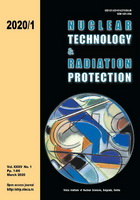
A COMPARATIVE STUDY BETWEEN NANO-CADMIUM OXIDE AND LEAD OXIDE REINFORCED IN HIGH DENSITY POLYETHYLENE AS GAMMA RAYS SHIELDING COMPOSITES
Pages: 42-49
Authors: Gharam A. Alharshan, Dalal A. Aloraini, Mohamed Abd Elzaher, Mohamed S. Badawi, Mahmoud T. Alabsy, Mahmoud I. Abbas, and Ahmed M. EL-KhatibAbstract
In this work, polymer composites of high density polyethylene reinforced by micro-sized and nanosized cadmium oxide, lead oxide, and a mixture of both with filler weight fraction of 30% were prepared by compression molding technique and characterized by scanning electron microscope. This investigation aims to present a comparative study between cadmium oxide and lead oxide according to their sizes as fillers in high density polyethylene polymeric matrix for gamma-radiation shielding applications. The mass and linear attenuation coefficients of the investigated composites were measured as a function of γ-ray energies ranging from 59.53 keV to 1408.01 keV using standard radioactive point sources (241Am, 133Ba, 137Cs, 60Co, and 152Eu). The measurements were made with a narrow beam geometry setup using a well calibrated hyper pure germanium cylindrical detector. The theoretical values of the mass attenuation coefficients were evaluated using the XCOM program database. The experimental results demonstrated that, according to the filler size, cadmium oxide composite is better as a gamma absorber in the energy region less than 81 keV, while lead oxide composite is better in the energy region greater than 81 keV. Moreover, for the same chemical structure and weight fraction of the composite, nano fillers show better attenuation performance than micro fillers in high density polyethylene based radiation shielding material.
Key words: linear attenuation coefficient, high density polyethylene composites, nano-cadmium oxide,nano-lead oxide, gamma radiation shielding
FULL PAPER IN PDF FORMAT (1,37 MB)
